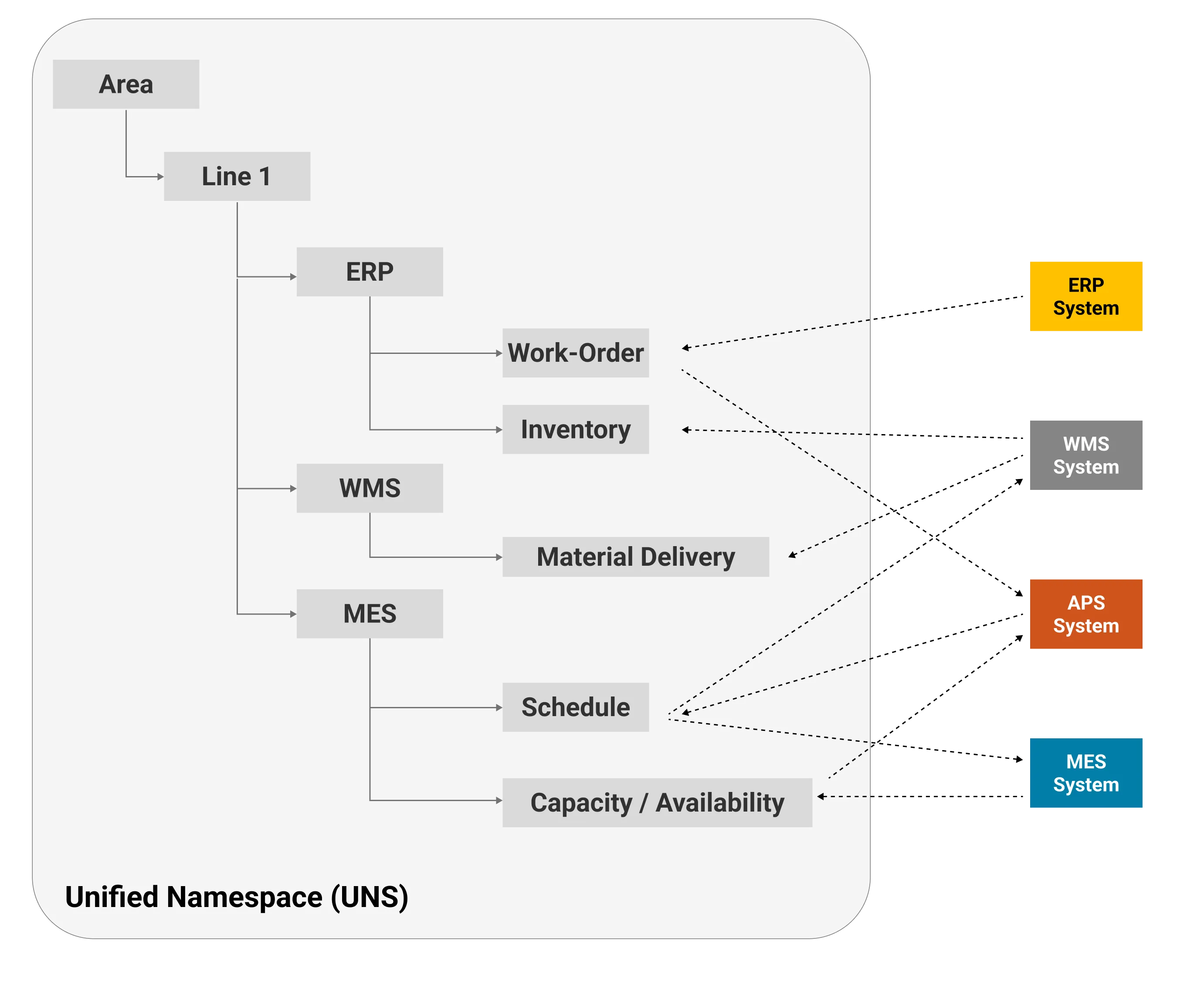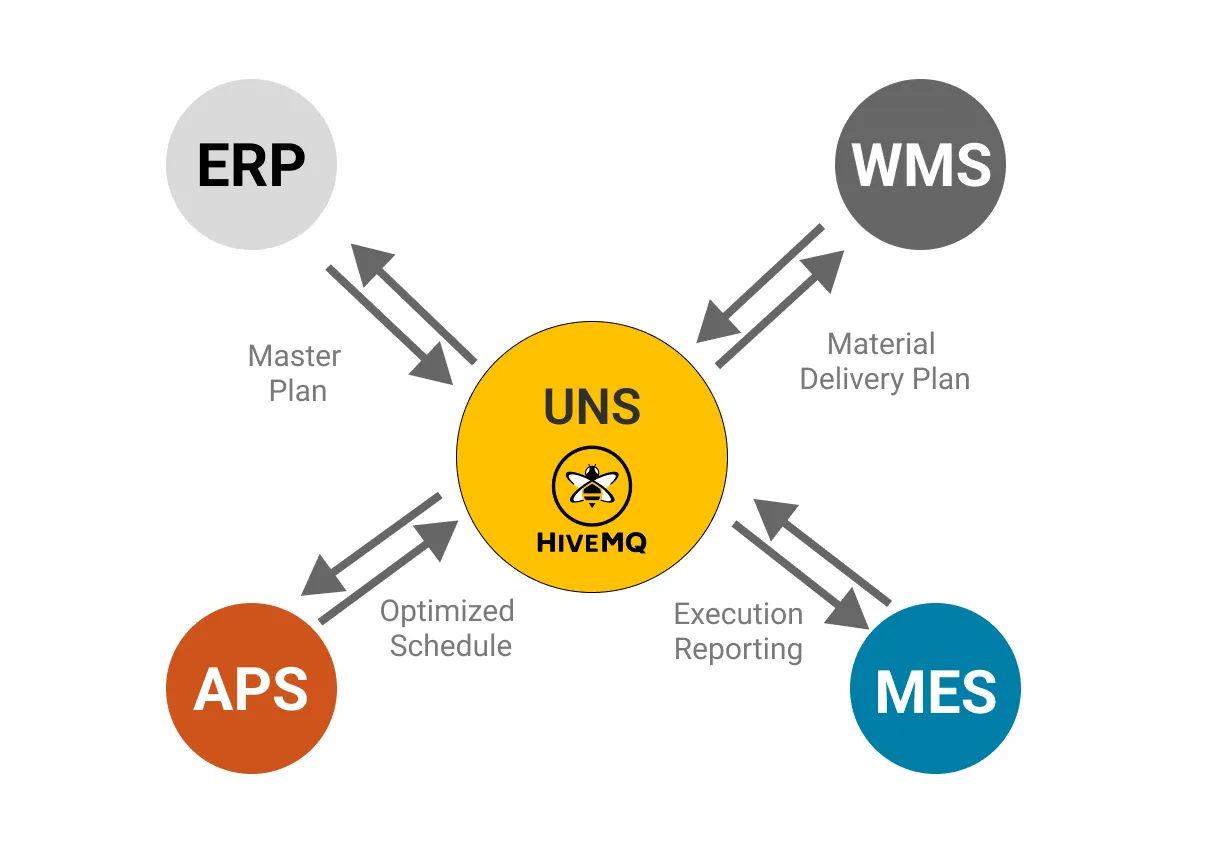Enabling Efficient Warehouse Operations with a Unified Namespace (UNS)
As manufacturing becomes increasingly complex and market demands grow more unpredictable, efficient warehouse management has never been more critical. Traditional paper-based or isolated digital solutions struggle to keep up with real-time requirements, leaving gaps in visibility and creating bottlenecks in the flow of materials. By embracing digitalization, warehouses can enhance inventory accuracy, streamline order processing, support production more effectively, and respond faster to changes in both demand and supply.
In one of our previous blog posts, we explored how a Unified Namespace (UNS) strategy supports agile shop-floor scheduling and a consolidated view of production order status. This blog post focuses on a vital dimension: how the UNS framework powers more efficient and resilient warehouse operations by enabling digital integration of the Warehouse Management System (WMS).
Challenges of Digitally Isolated WMS Systems in Manufacturing
Many manufacturers still rely on siloed systems for key warehouse tasks, creating data inconsistencies and communication gaps. An example of this fragmentation can be seen when an ERP holds purchase orders while a WMS manages inventory in a separate database. Because updates are often carried out manually, discrepancies in stock levels or order statuses can easily occur. The resulting delays and inaccuracies lead to production slowdowns, inventory overages, or missed deadlines.
A second challenge arises from the complex interdependencies within the manufacturing process. When changes to the production schedule are not automatically communicated to the warehouse, materials can be out of sync with real-time needs. In such scenarios, employees might scramble at the last minute to procure the correct items, or production lines stand idle waiting for delayed supplies.
Lack of real-time visibility further exacerbates the problem. Without immediate insight into current inventory levels, staff may inadvertently overstock or miss timely reorders. This issue not only drives up holding costs but also increases the likelihood of downtime when crucial materials are unavailable.
Finally, many warehouses still rely heavily on manual processes—often involving spreadsheets, emails, or handwritten logs—to track inventory movement. Human error becomes more likely, and data lags accumulate, undermining the overall efficiency and accuracy of warehouse operations.
Requirements for Digitalized Warehouse Operations
To overcome these challenges, manufacturers need a robust approach that ensures seamless communication and real-time data sharing across ERP, APS, MES, and Warehouse Management Systems (WMS). The following elements are essential:
Order Management
Automatic Order Processing: As production orders change in ERP, the warehouse instantly receives updated demands.
Just-in-Time Delivery Scheduling: Materials are delivered exactly when needed on the production line.
Seamless Integration with Production
Production Support: Materials must be staged where they are needed, when they are needed, to avoid delays.
Workflow Optimization: Automated routing of materials and tasks ensures a steady flow with minimal bottlenecks.
Quality Control and Traceability
Inspections and Testing: The ability to integrate warehouse data with quality control systems ensures that only compliant materials are released to production.
Batch/Lot Tracking: Detailed records of each material’s journey through the warehouse and into production are crucial for auditability and recalls.
Unified Data Model and Standardized Interfaces
Single Source of Truth: The activities of all the relevant stakeholders (APS, MES, ERP, etc.) that the Warehouse Management System (WMS) cares about must be visible to it under a real-time unified data model.
How the UNS Framework Drives Effective Warehouse Digitalization
The Unified Namespace acts as an open, standardized hub through which all systems—ERP, APS, MES, and the Warehouse Management System (WMS)—exchange events in real time. By publishing and subscribing to relevant data topics, each component of the manufacturing ecosystem remains in sync without needing tightly coupled point-to-point integrations.
The Warehouse Management System (WMS) subscribes to the UNS to listen to the scheduler’s optimized plan. By doing so, it knows which orders (and their required materials) will be executed and when.
Using that information, the WMS arranges for materials to be delivered to the correct machines in time. It may also adjust inventory counts in real-time, publishing those changes back to the ERP or an inventory topic in the UNS.
The WMS might then publish a Material Delivery event that includes specifics on which materials are being moved, from which location, and to which machine.
Below is an example namespace for the exchange of information between WMS and other systems through the UNS.
 By implementing a Unified Namespace as the central data-sharing mechanism, manufacturers transform warehouse operations from a series of isolated activities into an integrated, intelligently orchestrated network.
By implementing a Unified Namespace as the central data-sharing mechanism, manufacturers transform warehouse operations from a series of isolated activities into an integrated, intelligently orchestrated network.
Whenever the APS (Advanced Planning and Scheduling) solution optimizes a new plan, it publishes the requirements (quantities, part numbers, due dates) to the UNS.
The WMS, listening to these updates, orchestrates the picking and staging of components just in time for assembly.
If a last-minute demand spike occurs, APS publishes a revised schedule, and the WMS can immediately respond by adjusting pick/pack tasks.
 Conclusion
Conclusion
As manufacturers strive for greater agility and responsiveness, warehouse operations must evolve beyond siloed systems and manual processes. A Unified Namespace (UNS) provides the foundation for this transformation by enabling real-time, event-driven communication between the Warehouse Management System (WMS), ERP, APS, MES, and other critical components.
By subscribing to and publishing relevant data topics, the WMS gains real-time visibility into production needs and inventory changes, ensuring materials are delivered just in time and operations remain synchronized. This level of integration leads to improved accuracy, faster response to changes, reduced downtime, and ultimately, a more resilient and efficient warehouse operation that supports the broader goals of smart manufacturing. Stay tuned to the HiveMQ blog as I share many more use cases in upcoming posts.

Kudzai Manditereza
Kudzai is a tech influencer and electronic engineer based in Germany. As a Sr. Industry Solutions Advocate at HiveMQ, he helps developers and architects adopt MQTT and HiveMQ for their IIoT projects. Kudzai runs a popular YouTube channel focused on IIoT and Smart Manufacturing technologies and he has been recognized as one of the Top 100 global influencers talking about Industry 4.0 online.
